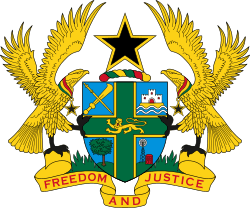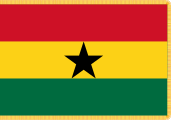List of heads of state of Ghana
This is a list of the heads of state of Ghana, from the independence of Ghana in 1957 to the present day.[1]
 |
|---|
| This article is part of a series on the politics and government of Ghana |
| Constitution |
|
Executive |
|
Legislative |
|
|
|
|
From 1957 to 1960 the head of state under the Constitution of 1957 was the Queen of Ghana, Elizabeth II, who was also the Monarch of the United Kingdom and the other Commonwealth realms.[2] The Queen was represented in Ghana by a Governor-General.[3] Ghana became a republic under the Constitution of 1960 and the Monarch and Governor-General were replaced by an executive President.[4]
Monarch (1957–1960)
The succession to the throne was the same as the succession to the British throne.
| No. | Portrait | Monarch (Birth–Death) |
Reign | Royal House | Prime Minister | ||
|---|---|---|---|---|---|---|---|
| Reign start | Reign end | Duration | |||||
| 1 | .jpg) |
Queen Elizabeth II (1926–) |
6 March 1957 | 1 July 1960 | 3 years, 117 days | Windsor | Nkrumah |
Governor-General
The Governor-General was the representative of the Monarch in Ghana and exercised most of the powers of the Monarch.[5] The Governor-General was appointed for an indefinite term, serving at the pleasure of the monarch. Since Ghana was granted independence by the Ghana Independence Act 1957, rather than being first established as a semi-autonomous Dominion and later promoted to independence by the Statute of Westminster 1931,[6] the Governor-General was to be always appointed solely on the advice of the Cabinet of Ghana without the involvement of the British government, with the sole exception of Charles Arden-Clarke, the former colonial governor, who served as Governor-General temporarily until he was replaced by William Hare.[7] In the event of a vacancy the Chief Justice served as Officer Administering the Government.[8]
- Status
| No. | Portrait | Governor-General (Birth–Death) |
Term of office | Monarch | Prime Minister | ||
|---|---|---|---|---|---|---|---|
| Took office | Left office | Time in office | |||||
| 1 |  |
Sir Charles Arden-Clarke (1898–1962) |
6 March 1957 | 14 May 1957 | 69 days | Elizabeth II | Nkrumah |
| – |  |
Sir Kobina Arku Korsah (1894–1967) |
14 May 1957 | 13 November 1957 | 183 days | Elizabeth II | Nkrumah |
| 2 |  |
The Rt. Hon. The Earl of Listowel (1906–1997) |
13 November 1957 | 1 July 1960 | 2 years, 231 days | Elizabeth II | Nkrumah |
First Republic (1960–1966)
Under the 1960 Constitution, the first constitution of the Republic of Ghana, the President replaced the Monarch as executive head of state.[9] The President was elected by Parliament for a 5-year term. In the event of a vacancy three Members of the Cabinet served jointly as Acting President.
- Status
| No. | Portrait | President (Birth–Death) |
Elected | Term of office | Political party | ||
|---|---|---|---|---|---|---|---|
| Took office | Left office | Time in office | |||||
| 1 | .jpg) |
Kwame Nkrumah (1909–1972) |
1960 1965 |
1 July 1960 | 26 February 1966 (deposed.) |
5 years, 240 days | Convention People's Party |
Military rule (1966–1969)
Lieutenant-General Joseph Arthur Ankrah led a coup d'état which overthrew President Nkrumah and his government, all political parties and Parliament were also dissolved.
| No. | Portrait | Head of State (Birth–Death) |
Term of office | Military | ||
|---|---|---|---|---|---|---|
| Took office | Left office | Time in office | ||||
| 2 |  |
Lieutenant-General Joseph Arthur Ankrah (1915–1992) |
24 February 1966 | 2 April 1969 (resigned.) |
3 years, 37 days | National Liberation Council |
| 3 |  |
Brigadier Akwasi Afrifa (1936–1979) |
2 April 1969 | 3 September 1969 | 154 days | National Liberation Council |
Second Republic (1969–1972)
- Status
| № | Portrait | President (Birth–Death) |
Elected | Term of office | Political party | Prime Minister | ||
|---|---|---|---|---|---|---|---|---|
| Took office | Left office | Time in office | ||||||
| (3) |  |
Brigadier Akwasi Afrifa (1936–1979) |
— | 3 September 1969 | 7 August 1970 | 338 days | Military | Busia |
| – |  |
Nii Amaa Ollennu (1906–1986) |
— | 7 August 1970 | 31 August 1970 | 24 days | Independent | |
| 4 |  |
Edward Akufo-Addo (1906–1979) |
— | 31 August 1970 | 13 January 1972 (deposed.) |
1 year, 135 days | Independent | |
Military rule (1972–1979)
General Ignatius Kutu Acheampong led a coup d'état which overthrew President Akufo-Addo, Prime Minister Abrefa Busia and his government, all political parties and Parliament were also dissolved.[10]
Lieutenant General Fred Akuffo led a coup d'état which overthrew the General Acheampong,[11] then Flight Lieutenant Jerry Rawlings led a coup d'état which overthrown the Supreme Military Council.[12]
| No. | Portrait | Head of State (Birth–Death) |
Term of office | Military | ||
|---|---|---|---|---|---|---|
| Took office | Left office | Time in office | ||||
| 5 |  |
General Ignatius Kutu Acheampong (1931–1979) |
13 January 1972 | 9 October 1975 | 6 years, 173 days | National Redemption Council |
| 9 October 1975 | 5 July 1978 (deposed.) |
Supreme Military Council | ||||
| 6 |  |
Lieutenant-General Fred Akuffo (1937–1979) |
5 July 1978 | 4 June 1979 (deposed.) |
334 days | Supreme Military Council |
| 7 | _(cropped).jpg) |
Flight Lieutenant Jerry Rawlings (1947–) |
4 June 1979 | 24 September 1979 | 112 days | Armed Forces Revolutionary Council |
Third Republic (1979–1981)[13]
Under the 1979 Constitution the President is head of both state and government. The President is elected by Ghanaians and serves a four-year term that expires at the next general election; a President may serve a maximum of two terms.[14] In the event of a vacancy the Vice-President serves as Acting President.[15]
- Status
| No. | Portrait | President (Birth–Death) |
Elected | Term of office | Political party | ||
|---|---|---|---|---|---|---|---|
| Took office | Left office | Time in office | |||||
| 8 |  |
Hilla Limann (1934–1998) |
1979 | 24 September 1979 | 31 December 1981 (deposed.) |
2 years, 98 days | People's National Party |
Military rule (1981–1993)
Flight Lieutenant Jerry Rawlings led a coup d'état which overthrew President Limann and his government, all political parties and Parliament were also dissolved.[16][17]
| No. | Portrait | Head of State (Birth–Death) |
Term of office | Political party | ||
|---|---|---|---|---|---|---|
| Took office | Left office | Time in office | ||||
| (7) | _(cropped).jpg) |
Flight Lieutenant Jerry Rawlings (1947–) |
31 December 1981 | 7 January 1993 | 11 years, 7 days | Provisional National Defence Council |
Fourth Republic (1993–present)
Under the current Constitution the President is head of both state and government.[18][19] The President is elected by Ghanaians and serves a four-year term that expires at the next general election; a President may serve a maximum of two terms. In the event of a vacancy, the Vice-President serves the remaining time as the President.[20]
- Status
| No. | Portrait | President (Birth–Death) |
Elected | Term of office | Political party | ||
|---|---|---|---|---|---|---|---|
| Took office | Left office | Time in office | |||||
| (7) | _(cropped).jpg) |
Jerry Rawlings (1947–) |
1992 1996 |
7 January 1993 | 7 January 2001 | 8 years | National Democratic Congress |
| 9 | John Kufuor (1938–) |
2000 2004 |
7 January 2001 | 7 January 2009 | 8 years | New Patriotic Party | |
| 10 | .jpg) |
John Atta Mills (1944–2012) |
2008 | 7 January 2009 | 24 July 2012 (died in office.) |
3 years, 199 days | National Democratic Congress |
| 11 | .jpg) |
John Mahama (1958–) |
2012 | 24 July 2012 | 7 January 2017 | 4 years, 167 days | National Democratic Congress |
| 12 |  |
Nana Akufo-Addo (1944–) |
2016 | 7 January 2017 | Incumbent | 3 years, 223 days | New Patriotic Party |
Standards
.svg.png) Governor-General's Standard
Governor-General's Standard Presidential Standard
Presidential Standard
Living former heads of state [21]
| Image | Name | Term/Reign | Office | Date of birth |
|---|---|---|---|---|
 |
Elizabeth II | 1957–1960 | Queen of Ghana | 21 April 1926 |
_(cropped).jpg) |
Jerry Rawlings | 1979 1981–1993 1993–2001 |
Military ruler President of Ghana |
22 June 1947 |
 |
John Kufuor | 2001–2009 | President of Ghana | 8 December 1938 |
.jpg) |
John Dramani Mahama | 2012–2017 | President of Ghana | 29 November 1958 |
References
- "Independence, Coups, and the Republic, 1957–Present", The Ghana Reader, Duke University Press, pp. 299–300, ISBN 978-0-8223-7496-1, retrieved 2020-05-30
- "Magnum Photos". pro.magnumphotos.com. Retrieved 2020-05-26.
- "Magnum Photos". pro.magnumphotos.com. Retrieved 2020-05-26.
- "Ghana - INDEPENDENT GHANA". countrystudies.us. Retrieved 2020-05-26.
- Vandrei, Martha (2018-07-19). "'That ubiquitous monarch'". Oxford Scholarship Online. doi:10.1093/oso/9780198816720.003.0007.
- Ibingira, Grace Stuart (2019-04-30), "Ghana", African Upheavals Since Independence, Routledge, pp. 51–59, ISBN 978-0-429-05200-2, retrieved 2020-05-30
- "Lewis, Sir Allen (Montgomery), (26 Oct. 1909–18 Feb. 1993), Governor-General of St Lucia, 1982–87 (first Governor-General, 1979–80; Governor, 1974–79)", Who Was Who, Oxford University Press, 2007-12-01, retrieved 2020-05-30
- Prempeh, H. Kwasi (2013-07-30). "Constitutional autochthony and the invention and survival of "absolute presidentialism" in postcolonial Africa". Order from Transfer.
- Todd E, Pettys (2018-02-09). "Part Two The Iowa Constitution and Commentary, Art.IV Executive Department". The Iowa State Constitution. doi:10.1093/law/9780190490836.003.0007.
- "Busia, Dr Kofi Abrefa, (11 July 1913–28 Aug. 1978), Prime Minister of Ghana, 1969–72", Who Was Who, Oxford University Press, 2007-12-01, retrieved 2020-05-30
- Rich, Jeremy (2011-12-08), "Akuffo, Fred", African American Studies Center, Oxford University Press, ISBN 978-0-19-530173-1, retrieved 2020-05-30
- Shillington, Kevin. (1992). Ghana and the Rawlings factor. Macmillan. ISBN 0-333-56845-1. OCLC 28182404.
- Nketia, J.H. Kwabena (2001). Ghana, Republic of. Oxford Music Online. Oxford University Press.
- Yankson-Mensah, Marian. (2020). Transitional justice in Ghana an appraisal of the National Reconciliation Commission. T.M.C. Asser Press. ISBN 978-94-6265-379-5. OCLC 1151190908.
- Nketia, J.H. Kwabena (2001). Ghana, Republic of. Oxford Music Online. Oxford University Press.
- Gyimah-Boadi, E. (1993). Ghana under the PNDC rule. CODESRIA. ISBN 2-86978-018-4. OCLC 475366719.
- Isaacs, Anita (1993), "Development and Reform under Military Rule", Military Rule and Transition in Ecuador, 1972–92, Palgrave Macmillan UK, pp. 35–65, ISBN 978-1-349-08924-6, retrieved 2020-05-30
- Nketia, J.H. Kwabena (2001). Ghana, Republic of. Oxford Music Online. Oxford University Press.
- "Ghana - Constitution & Politics". Foreign Law Guide. Retrieved 2020-05-30.
- "Ghana - Constitution & Politics". Foreign Law Guide. Retrieved 2020-05-30.
- Ghana. Information Services Department. (1991). Ghana and the Non-aligned Movement. Information Services Dept. OCLC 27080222.